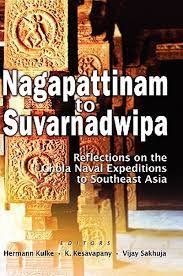Nagapattinam to Suvarnadwipa: Reflections on Chola Naval Expeditions to Southeast Asia

Review by ANIMESH ROUL (December 30, 2010): The Chief Minister of India’s Southern State, Tamil Nadu, recently named a male tiger cub “Sembian” (meaning, winning a Tiger) in memory of the great Cholas who ruled over Southern India and a tiger as a symbol on their flag. This gesture shows the lasting influence of ‘Great Cholas’ on modern and contemporary Tamil society.
Cholas, one of the longest-ruling Hindu dynasties of southern India, ruled for nearly a thousand years (from 3rdCentury BC till 13th Century AD) and is credited for the uniting large portion of India’s peninsular landmass, parts of present Sri Lanka and Maldives group of Islands. Arguably, the dynasty reached its zenith during the rule of Rajaraja Chola I and his son Rajendra Chola I when it became an economic and military power, expanding its influence beyond South Asia and reaching the coasts of China and Southeast Asian countries in the Malayan peninsula. Two things stand out as far as the international influence of Cholas is concerned: Maritime trade and expeditions to Southeast Asia (and even Iraq) and the patronage of the architecture and literature.
To celebrate or (to recollect rather) this lasting legacy of Cholas, the ISEAS (Institute of Southeast Asian Studies), Singapore, brings out an informative compilation titled “Nagapattinam To Suvarnadwipa: Reflections On Chola Naval Expeditions To Southeast Asia” (Editors: Hermann Kulke, K. Kesavapany, Vijay Sakhuja, 2009) which not only opens a whole new understanding of India’s historical links with Southeast Asia including China but also the volume underscores the naval conquest and flourishing trade and commerce with coastal cities in Southeast Asia (e.g the kingdom of Srivijaya).
The book consists of fifteen chapters, approximately 315 pages of text excluding an index, and a couple of important sections on Ancient and Medieval Tamil and Sanskrit Inscriptions depicting Cholan ties with Southeast Asia and China and English translations of earliest Chinese Texts (e.g., from the Song and Yuan periods) referring to the Chola Kingdom of India.
The first five chapters of the book deal with Cholas' naval expeditions, trade and commerce during that time, especially in the Indian Ocean, military campaigns under Rajendra Chola, and his naval expedition to Southeast Asia.
Undoubtedly, the Imperial Cholas’ achieved naval supremacy only during the reign of Rajaraja Chola and his successor Rajendra Chola-I. One the editors of the book, Indologist Hermann Kulke’s chapter depicts this aspect of Naval domination by father son duo Rajaraja and Rajendra Cholas on the Peninsular India and Malayan Archipelago. Evidently, under Rajendra Chola-I, the Cholas actually employed their strong Naval power to expand and consolidate their empire by subjugating many kingdoms of Southeast Asia that included present day Myanmar, Cambodia and Malaysia.
The other interesting focus of the book is South India’s merchant guilds (Chapters 8 and 9), which were the contribution of Cholas and regarded as the ‘driving force’ behind all the naval expeditions, especially against Srivijaya (a geographical area resembling modern Indonesia). The discussions on the important guilds Ainurruvar and Anjuvannam (the maritime guild) are certainly illuminating.
Interestingly, the book is unique in many aspects. It is historical but interesting in terms of the analysis of revealing facts that the authors have probed through meticulous study of Tamil and Sanskrit inscriptions, prasastis and Chinese texts. The book also sheds some light and raises some vital issues comparing the Seafaring and trading activities of Cholas with the contemporary international relations point of view, especially Sino-Indian ties and the Indian look east policy.
ANIMESH ROUL, Executive Director, Society for the Study of Peace and Conflict, New Delhi. This book review was originally published in the Indian Foreign Affairs Journal, Vol. 5, No. 4 (Oct-Dec 2010): 507-508.